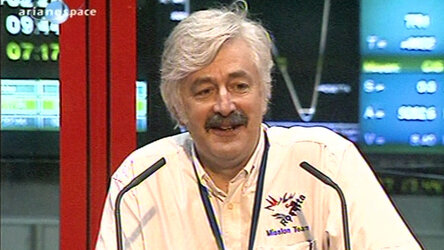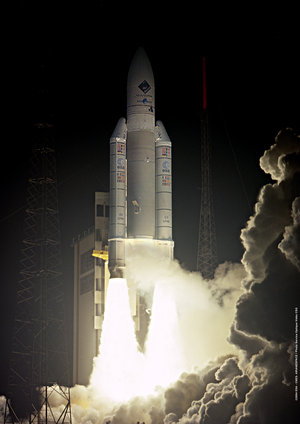Accept all cookies Accept only essential cookies See our Cookie Notice

About ESA
The European Space Agency (ESA) is Europe’s gateway to space. Its mission is to shape the development of Europe’s space capability and ensure that investment in space continues to deliver benefits to the citizens of Europe and the world.
Highlights
ESA - United space in Europe
This is ESA ESA facts Member States & Cooperating States Funding Director General Top management For Member State Delegations European vision European Space Policy ESA & EU Space Councils Responsibility & Sustainability Annual Report Calendar of meetings Corporate newsEstablishments & sites
ESA Headquarters ESA ESTEC ESA ESOC ESA ESRIN ESA EAC ESA ESAC Europe's Spaceport ESA ESEC ESA ECSAT Brussels Office Washington OfficeWorking with ESA
Business with ESA ESA Commercialisation Gateway Law at ESA Careers Cyber resilience at ESA IT at ESA Newsroom Partnerships Merchandising Licence Education Open Space Innovation Platform Integrity and Reporting Administrative Tribunal Health and SafetyMore about ESA
History ESA Historical Archives Exhibitions Publications Art & Culture ESA Merchandise Kids Diversity ESA Brand Centre ESA ChampionsLatest
Space in Member States
Find out more about space activities in our 23 Member States, and understand how ESA works together with their national agencies, institutions and organisations.
Science & Exploration
Exploring our Solar System and unlocking the secrets of the Universe
Go to topicAstronauts
Missions
Juice Euclid Webb Solar Orbiter BepiColombo Gaia ExoMars Cheops Exoplanet missions More missionsActivities
International Space Station Orion service module Gateway Concordia Caves & Pangaea BenefitsLatest
Space Safety
Protecting life and infrastructure on Earth and in orbit
Go to topicAsteroids
Asteroids and Planetary Defence Asteroid danger explained Flyeye telescope: asteroid detection Hera mission: asteroid deflection Near-Earth Object Coordination CentreSpace junk
About space debris Space debris by the numbers Space Environment Report In space refuelling, refurbishing and removingSafety from space
Clean Space ecodesign Zero Debris Technologies Space for Earth Supporting Sustainable DevelopmentLatest
Applications
Using space to benefit citizens and meet future challenges on Earth
Go to topicObserving the Earth
Observing the Earth Future EO Copernicus Meteorology Space for our climate Satellite missionsCommercialisation
ESA Commercialisation Gateway Open Space Innovation Platform Business Incubation ESA Space SolutionsLatest
Enabling & Support
Making space accessible and developing the technologies for the future
Go to topicBuilding missions
Space Engineering and Technology Test centre Laboratories Concurrent Design Facility Preparing for the future Shaping the Future Discovery and Preparation Advanced Concepts TeamSpace transportation
Space Transportation Ariane Vega Space Rider Future space transportation Boost! Europe's Spaceport Launches from Europe's Spaceport from 2012Latest

Rosetta: lift-off
Thank you for liking
You have already liked this page, you can only like it once!
Surrounded by four 100-m lightning towers, the first Ariane 5G+, atop its mobile launch platform, stands on the pad at the Launch Zone (ZL-3) of the Ariane Launch Complex no.3 (ELA-3) at the Guiana Space Centre, Europe's space port, on the evening of February 24, 2004, during final preparation for a first launch attempt two days later.
Selected in November 1993 as a "Cornerstone" mission of ESA's long-term science program "Horizon 2000", the Rosetta probe was initially planned for launch on the V158 flight in January 2003 for an eight-year journey to the comet 46P/Wirtanen. Due to delays in the Ariane 5 program, the initial launch campaign was interrupted in December 2002 and the mission was redesigned for a launch toward the comet 67P/Churyumov-Gerasimenko.
Build by EADS Astrium, the Rosetta probe consists in a 3,065-kg spacecraft (1,578-kg dry mass) designed to enter orbit around the comet's nucleus in August 2014 after a series of gravity assist manoeuvres to gain enough orbital energy, flying three times by Earth (March 2005, November 2007 and November 2009) and once by Mars (February 2007). En route to the comet, the probe will flyby the asteroids 2867 Steins (September 2008) and 21 Lutetia (July 2010).
The spacecraft will map the comet's surface in fine detail and land a package of instruments (the Rosetta Lander) to study some of the most primitive, unprocessed material in the solar system. The mission will provide clues to the physical and chemical processes that marked the systems beginning 4.6 billion years ago.
-
CREDIT
ESA–S. Corvaja -
LICENCE
ESA Standard Licence

Rosetta on the way to Comet 67/P

Rosetta - the comet chaser

Rosetta lift-off

Ariane 5 V158















 Germany
Germany
 Austria
Austria
 Belgium
Belgium
 Denmark
Denmark
 Spain
Spain
 Estonia
Estonia
 Finland
Finland
 France
France
 Greece
Greece
 Hungary
Hungary
 Ireland
Ireland
 Italy
Italy
 Luxembourg
Luxembourg
 Norway
Norway
 The Netherlands
The Netherlands
 Poland
Poland
 Portugal
Portugal
 Czechia
Czechia
 Romania
Romania
 United Kingdom
United Kingdom
 Slovenia
Slovenia
 Sweden
Sweden
 Switzerland
Switzerland

























